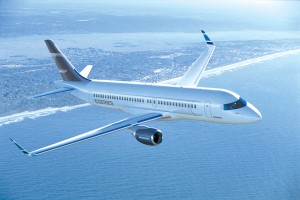By S. Clayton Moore

Bombardier’s new CSeries airliners will be offered in four different iterations designed to compete in the larger-sized regional aircraft market.
Not every aircraft manufacturer wants to jump into the risky business of competing with Boeing and Airbus, but Montreal-based Bombardier Aerospace intends to enter the airliner market. The company has confirmed that it’s developing plans for a $2 billion aircraft development program that will produce two new 110- and 135-seat aircraft for the regional market.
In late March, Bombardier announced that its board of directors has granted the company authority to offer the new family of aircraft to its customers. Dubbed the “CSeries”—for Competitive, Continental, Connector—the plane launches the company into a new multibillion dollar market.
“In the CSeries status report presented to board members, Bombardier Aerospace demonstrated the significant progress made in the evaluation of the aircraft configuration and performance, the strong market interest for the CSeries family as well as the overall business plan,” said president and CEO Pierre Beaudoin. “We will now offer sales proposals to potential customers and finalize sales and partnership commitments before returning to the board to request program launch and recommend the final assembly site location.”
The new line of Bombardier airliners will compete directly with Boeing’s 717-200, 737-600 and 737-700 as well as the Airbus A318 and A319, and also against Brazil’s Embraer, which has a significant head start on smaller transports. Embraer will begin deliveries of its 106-set 190 later this year and expects to begin deliveries of its 118-seat 195 in 2006.
The aircraft is expected to be manufactured in four different configurations using the same wing plan. The basic CSeries aircraft, in 110-seat and 135-seat iterations, is anticipated to have a maximum takeoff weight of 151,000 pounds and a range of 1,800 nautical miles. The longer-range CSeries 110LR will have a range of 3,250 nautical miles, and the 135Lr will cover the middle ground at 2,800 nautical miles.
Twenty percent of the aircraft by weight will be composed of composite materials, including the center and rear fuselages, tail cone and wings. The planes, averaging between 114 feet and 125 feet in length, will share part and maintenance procedures as well as operating procedures and crew training. Designed for five-abreast seating, the aircraft is designed with simultaneous servicing points for quick turnaround.
Engine and avionics suppliers have not been selected, but officials at Bombardier expect to select the vendors by the end of the year.
Bombardier manufacturing centers in Montreal and Toronto are high on the list of potential assembly sites, although the company’s assembly plant in Belfast, Northern Ireland, is also competing for the project. Earlier this year, Bombardier employees in Montreal agreed to make concessions in a new labor deal aimed at convincing the company to build the aircraft in Quebec.
Bombardier, along with Boeing, Airbus, Embraer and other manufacturers, are looking at the lucrative market for replacing the aging fleets of McDonnell Douglas DC-9s, Fokker 100s, early Boeing 737s and BAe 146s and MD80s that are beginning to leave service.
“The market for the 100- to 150-passenger commercial aircraft segment is estimated at $250 billion U.S., or roughly 6,000 aircraft over the next 20 years,” said Gary Scott, president of the Bombardier New Commercial Aircraft Program.
Scott also said last year that there is some potential for the CSeries to be used in business and corporate aviation.
“There is a huge potential customer base in the lower end of this segment, especially among existing main line and the fast-growing low-cost carriers. We are very excited about the prospects of developing a new family of aircraft that is optimized to meet their needs, and I’m pleased to say that our customers are telling us the same thing,” Scott said.
The company believes that the twin-engine aircraft could cut operating costs by 15 percent compared to the current narrow-body jetliners.
If the project moves forward as anticipated, the first deliveries of the basic CSeries aircraft could occur as early as 2010. Anticipated funding for the $2.1 billion program will be a three-way split between the Canadian government, suppliers and Bombardier.
The company has stressed that it’s being very careful in proving the commercial interest for the aircraft, taking more than a year to research and complete a feasibility study. Bombardier studied a similar project several years ago, but shelved it due to their financial constraints at that time.
However, some analysts have proposed that Bombardier had no choice but to move into larger aircraft as sales of smaller regional jets have declined. Range capabilities would allow airline networks to expand into point-to-point flying and rely less on hub-and-spoke operations.
Bombardier announced its initial plans at last year’s Farnborough Air Show, where the $2 billion program was one of the biggest news items of the event. The company ended 2004 with revenues of more than $15 billion.











